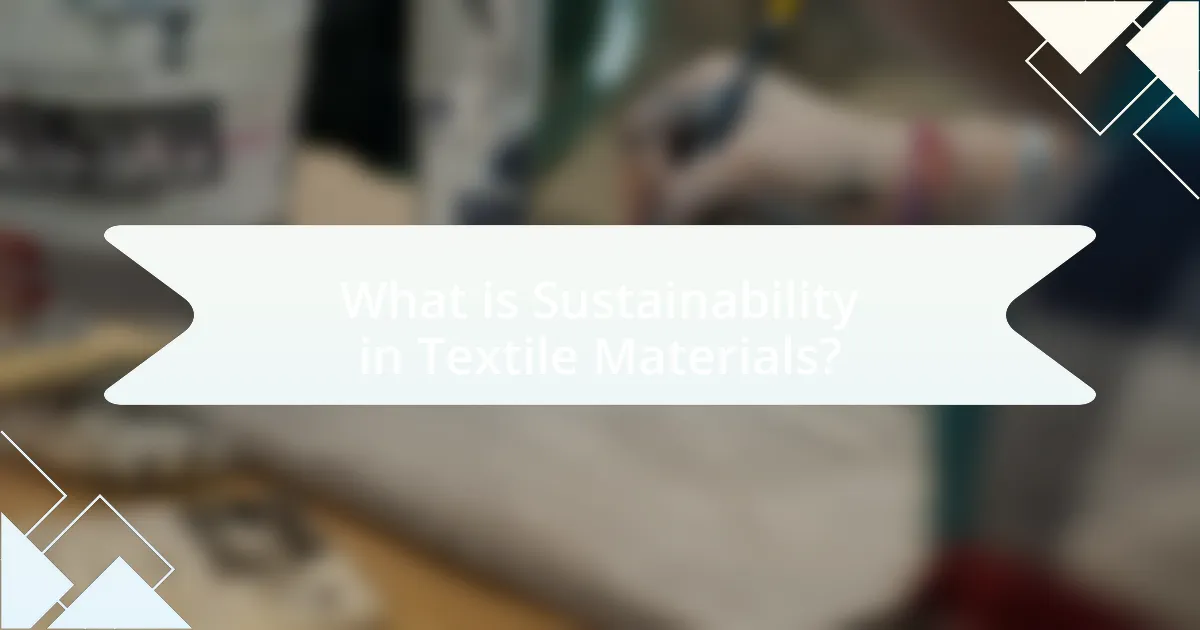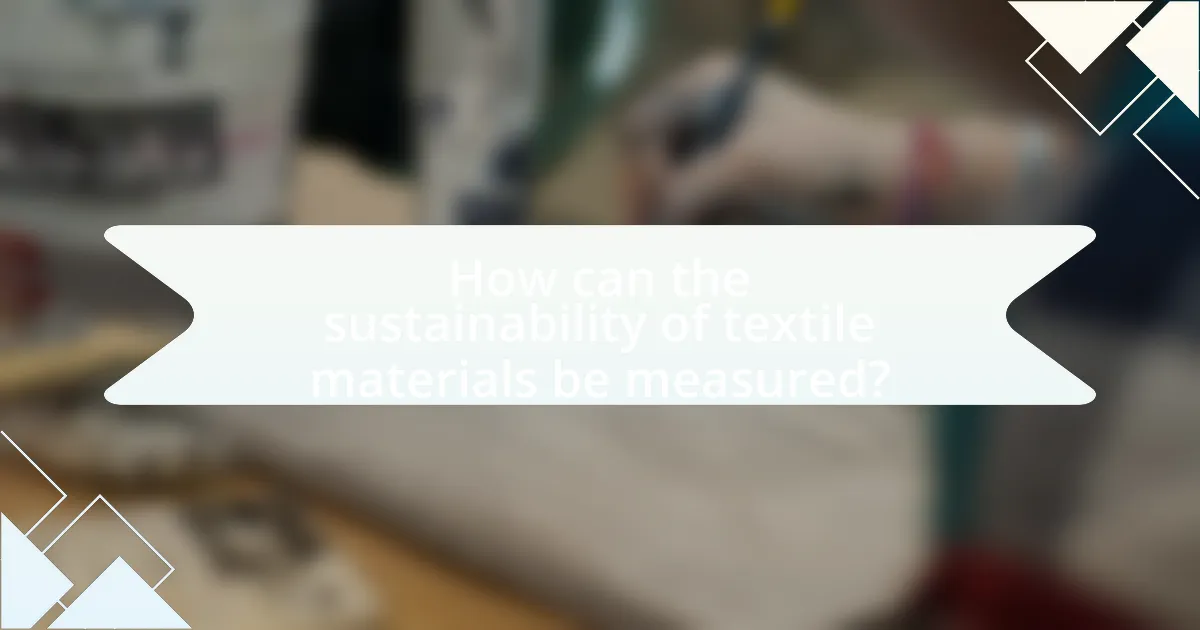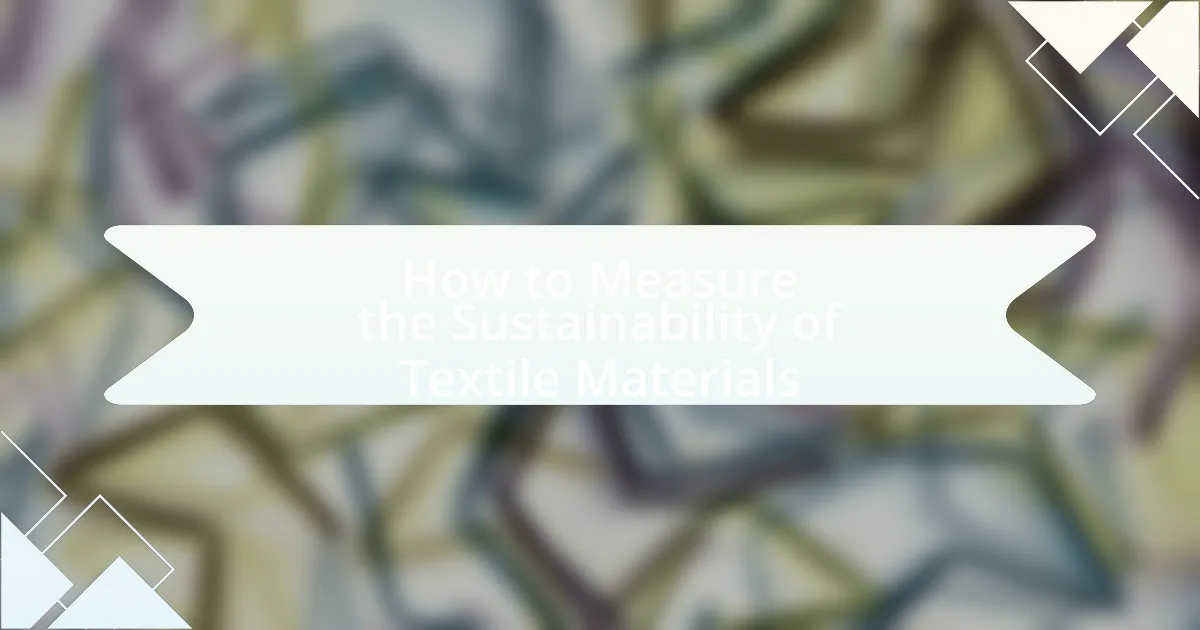Sustainability in textile materials encompasses the development and use of fabrics that minimize environmental impact and promote social responsibility throughout their lifecycle. This article explores the definition of sustainability in textiles, key principles of sustainable production, and the importance of adopting eco-friendly practices to mitigate the industry’s significant contribution to global carbon emissions. It also examines factors influencing sustainability, such as raw material sourcing, manufacturing processes, and end-of-life management, while highlighting the metrics and tools available for measuring sustainability, including life cycle assessments and certifications like GOTS and OEKO-TEX. Additionally, the article addresses challenges in measuring sustainability and offers best practices for brands to enhance their sustainability efforts and communicate them effectively to consumers.

What is Sustainability in Textile Materials?
Sustainability in textile materials refers to the development and use of fabrics that minimize environmental impact and promote social responsibility throughout their lifecycle. This includes sourcing raw materials from renewable resources, utilizing eco-friendly production processes, and ensuring that the end products are biodegradable or recyclable. For instance, organic cotton and recycled polyester are examples of sustainable textile materials that reduce water usage and waste. According to the Global Fashion Agenda, the fashion industry is responsible for 10% of global carbon emissions, highlighting the urgent need for sustainable practices in textile production to mitigate climate change.
How is sustainability defined in the context of textiles?
Sustainability in the context of textiles is defined as the ability to produce and use textile materials in a manner that minimizes environmental impact, promotes social equity, and ensures economic viability throughout the lifecycle of the products. This definition encompasses practices such as using renewable resources, reducing waste, and ensuring fair labor conditions. For instance, the Global Organic Textile Standard (GOTS) emphasizes organic farming, environmentally friendly processing, and social responsibility, illustrating how sustainability can be operationalized in the textile industry.
What are the key principles of sustainable textile production?
The key principles of sustainable textile production include resource efficiency, waste reduction, and ethical labor practices. Resource efficiency focuses on minimizing water and energy consumption during production processes, which can be achieved through technologies like closed-loop systems. Waste reduction emphasizes recycling and upcycling materials to decrease landfill contributions; for instance, the Global Fashion Agenda reports that 92 million tons of textile waste are generated annually. Ethical labor practices ensure fair wages and safe working conditions, aligning with the International Labour Organization’s standards. These principles collectively contribute to a more sustainable textile industry.
Why is sustainability important in the textile industry?
Sustainability is crucial in the textile industry because it addresses environmental degradation, resource depletion, and social inequities associated with textile production. The industry is one of the largest polluters globally, contributing to significant water pollution and greenhouse gas emissions. For instance, the World Bank estimates that the textile industry is responsible for 20% of global wastewater and 10% of carbon emissions. By adopting sustainable practices, such as using organic materials and reducing water consumption, the industry can minimize its ecological footprint and promote ethical labor practices, ultimately leading to a more responsible and resilient supply chain.
What factors contribute to the sustainability of textile materials?
The sustainability of textile materials is influenced by several key factors, including the choice of raw materials, production processes, and end-of-life management. Sustainable textiles often utilize organic or recycled fibers, which reduce environmental impact by minimizing resource consumption and waste. For instance, organic cotton uses 91% less water than conventional cotton and avoids harmful pesticides, contributing to soil health and biodiversity. Additionally, eco-friendly production methods, such as low-impact dyeing and energy-efficient manufacturing, further enhance sustainability by reducing carbon emissions and water pollution. Finally, effective end-of-life strategies, such as recycling and biodegradability, ensure that textiles do not contribute to landfill waste, promoting a circular economy. These factors collectively determine the overall sustainability of textile materials.
How do raw material sources impact sustainability?
Raw material sources significantly impact sustainability by determining the environmental footprint of production processes. For instance, the extraction and processing of natural fibers, such as cotton, often require substantial water and pesticide use, leading to soil degradation and water scarcity. In contrast, synthetic fibers, derived from petroleum, contribute to greenhouse gas emissions during production and create microplastic pollution in waterways. According to the Textile Exchange’s 2021 report, organic cotton uses 91% less water than conventional cotton, highlighting the importance of selecting sustainable raw materials. Thus, the choice of raw material sources directly influences ecological health, resource conservation, and overall sustainability in the textile industry.
What role does manufacturing process play in sustainability?
The manufacturing process plays a crucial role in sustainability by determining resource efficiency, waste generation, and environmental impact. Efficient manufacturing processes minimize energy consumption and reduce emissions, contributing to lower carbon footprints. For instance, the use of eco-friendly materials and technologies, such as waterless dyeing methods, can significantly decrease water usage and pollution. According to a study published in the Journal of Cleaner Production, implementing sustainable manufacturing practices can reduce energy consumption by up to 30% and waste by 50%, highlighting the direct correlation between manufacturing processes and sustainability outcomes.

How can the sustainability of textile materials be measured?
The sustainability of textile materials can be measured through various metrics, including life cycle assessment (LCA), carbon footprint analysis, water usage metrics, and social impact assessments. Life cycle assessment evaluates the environmental impacts of a textile from raw material extraction to disposal, providing a comprehensive view of its sustainability. Carbon footprint analysis quantifies greenhouse gas emissions associated with the production and use of textiles, while water usage metrics assess the volume of water consumed throughout the textile’s life cycle. Social impact assessments evaluate the effects of textile production on communities and labor conditions. These methods collectively offer a robust framework for measuring sustainability in textiles, supported by industry standards and research findings.
What metrics are used to assess textile sustainability?
Metrics used to assess textile sustainability include water usage, energy consumption, carbon footprint, and waste generation. Water usage metrics evaluate the volume of water consumed during production, while energy consumption metrics measure the energy required for manufacturing processes. The carbon footprint metric quantifies greenhouse gas emissions associated with the lifecycle of textiles, and waste generation metrics assess the amount of waste produced throughout the production and disposal phases. These metrics provide a comprehensive framework for evaluating the environmental impact of textile materials.
How is the carbon footprint of textiles calculated?
The carbon footprint of textiles is calculated by assessing the total greenhouse gas emissions produced throughout the entire lifecycle of the textile, from raw material extraction to production, distribution, use, and disposal. This calculation typically involves using life cycle assessment (LCA) methodologies, which quantify emissions in terms of carbon dioxide equivalents (CO2e) based on data from various stages, including energy consumption, transportation, and waste management. For instance, a study published in the Journal of Cleaner Production indicates that the production phase alone can account for up to 70% of a textile’s total carbon footprint, highlighting the importance of evaluating each stage comprehensively to obtain an accurate measurement.
What is the significance of water usage in textile sustainability assessments?
Water usage is significant in textile sustainability assessments because it directly impacts environmental health and resource conservation. The textile industry is one of the largest consumers of water, with estimates indicating that producing a single cotton t-shirt can require up to 2,700 liters of water. This high water consumption contributes to water scarcity in many regions, affecting local communities and ecosystems. Additionally, assessing water usage helps identify opportunities for reducing water waste and improving efficiency, which are crucial for sustainable practices. By evaluating water usage, stakeholders can make informed decisions that promote sustainable sourcing and production methods, ultimately leading to a more responsible textile industry.
What tools and standards exist for measuring sustainability?
Tools and standards for measuring sustainability in textile materials include the Global Organic Textile Standard (GOTS), the OEKO-TEX certification, and the Higg Index. GOTS sets criteria for organic fibers and ensures environmentally and socially responsible manufacturing processes. OEKO-TEX provides testing for harmful substances in textiles, ensuring safety for consumers. The Higg Index, developed by the Sustainable Apparel Coalition, offers a suite of tools to measure environmental and social sustainability across the supply chain. These standards are widely recognized and help brands assess and improve their sustainability practices effectively.
How do certifications like GOTS and OEKO-TEX contribute to sustainability measurement?
Certifications like GOTS (Global Organic Textile Standard) and OEKO-TEX contribute to sustainability measurement by providing standardized criteria for assessing the environmental and social impacts of textile production. GOTS ensures that textiles are made from organic fibers and processed in an environmentally and socially responsible manner, covering aspects such as water usage, chemical management, and fair labor practices. OEKO-TEX, on the other hand, focuses on the safety of textiles for human health, certifying that products are free from harmful substances. These certifications enable consumers and manufacturers to make informed choices, as they rely on rigorous testing and compliance with established sustainability benchmarks, thus promoting transparency and accountability in the textile industry.
What role do life cycle assessments (LCAs) play in evaluating textile sustainability?
Life cycle assessments (LCAs) play a critical role in evaluating textile sustainability by providing a comprehensive analysis of the environmental impacts associated with each stage of a textile’s life cycle, from raw material extraction to disposal. LCAs quantify resource use, emissions, and waste generation, enabling stakeholders to identify areas for improvement and make informed decisions regarding sustainable practices. For instance, a study published in the Journal of Cleaner Production found that LCAs can reveal that the production phase of textiles often has the highest environmental impact, prompting manufacturers to adopt more sustainable sourcing and production methods. This data-driven approach ensures that sustainability efforts are targeted and effective, ultimately contributing to a more sustainable textile industry.

What are the challenges in measuring textile sustainability?
Measuring textile sustainability faces several challenges, primarily due to the complexity of the supply chain and the lack of standardized metrics. The textile industry involves multiple stages, from raw material extraction to production, distribution, and disposal, making it difficult to assess the overall environmental impact accurately. Additionally, the absence of universally accepted sustainability indicators complicates comparisons across different materials and processes. For instance, while some organizations may prioritize water usage, others might focus on carbon emissions, leading to inconsistent evaluations. Furthermore, the dynamic nature of sustainability practices, which evolve with technological advancements and regulatory changes, adds another layer of difficulty in establishing a stable measurement framework.
What limitations exist in current sustainability measurement methods?
Current sustainability measurement methods face several limitations, including a lack of standardized metrics, which leads to inconsistent results across different assessments. For instance, various frameworks like Life Cycle Assessment (LCA) and Environmental Product Declarations (EPD) may use different criteria, making comparisons difficult. Additionally, many methods do not account for social and economic dimensions of sustainability, focusing primarily on environmental impacts. This narrow scope can result in an incomplete understanding of a product’s overall sustainability. Furthermore, data availability and quality can hinder accurate assessments, as many companies do not disclose comprehensive information about their supply chains. These limitations highlight the need for more integrated and standardized approaches to effectively measure sustainability in textile materials.
How do varying definitions of sustainability affect measurement consistency?
Varying definitions of sustainability significantly affect measurement consistency by creating discrepancies in evaluation criteria and metrics used across different contexts. For instance, one definition may emphasize environmental impact, while another may prioritize social equity or economic viability. This lack of a unified framework leads to inconsistent data collection methods and varying interpretations of what constitutes sustainable practices. Research by the United Nations in 2015 highlighted that the absence of a standardized definition complicates the assessment of sustainability in various sectors, including textiles, resulting in challenges in comparing sustainability metrics across studies and industries.
What are the difficulties in obtaining accurate data for sustainability assessments?
Obtaining accurate data for sustainability assessments is challenging due to issues such as data availability, variability in measurement standards, and the complexity of supply chains. Data availability is often limited, as many companies do not disclose detailed information about their materials and processes, making it difficult to assess sustainability accurately. Variability in measurement standards arises from the lack of universally accepted metrics for sustainability, leading to inconsistencies in data interpretation. Additionally, the complexity of supply chains, which can involve multiple stakeholders and processes, complicates the tracking of environmental impacts and resource usage, further hindering accurate assessments.
How can the textile industry overcome these challenges?
The textile industry can overcome challenges by adopting sustainable practices and technologies. Implementing circular economy principles, such as recycling and upcycling materials, reduces waste and resource consumption. For instance, the Global Fashion Agenda reports that transitioning to a circular model could reduce greenhouse gas emissions by 44% by 2030. Additionally, investing in innovative materials, like bio-based fibers and water-efficient dyeing processes, can significantly lower environmental impact. According to a study by McKinsey & Company, sustainable materials can reduce water usage by up to 90% compared to conventional methods. By prioritizing transparency in supply chains and collaborating with stakeholders, the industry can enhance sustainability and address consumer demand for ethical practices.
What innovations are being developed to improve sustainability measurement?
Innovations being developed to improve sustainability measurement in textile materials include advanced life cycle assessment (LCA) tools, blockchain technology for supply chain transparency, and artificial intelligence (AI) for data analysis. Advanced LCA tools enable more accurate assessments of environmental impacts throughout the product life cycle, allowing for better decision-making. Blockchain technology enhances traceability, ensuring that sustainability claims can be verified at each stage of production. AI algorithms analyze large datasets to identify patterns and optimize resource use, leading to more sustainable practices. These innovations collectively enhance the accuracy and reliability of sustainability measurements in the textile industry.
How can collaboration among stakeholders enhance sustainability practices?
Collaboration among stakeholders enhances sustainability practices by fostering shared knowledge, resources, and innovative solutions. When various stakeholders, including manufacturers, suppliers, consumers, and policymakers, work together, they can align their goals and strategies, leading to more effective implementation of sustainable practices. For instance, a study by the World Economic Forum highlights that collaborative initiatives in the textile industry can reduce waste by up to 30% through shared logistics and recycling programs. This collective approach not only improves efficiency but also drives the adoption of sustainable materials and technologies, ultimately contributing to a more sustainable textile supply chain.
What best practices can be adopted for measuring sustainability in textiles?
Best practices for measuring sustainability in textiles include utilizing life cycle assessment (LCA), adopting standardized sustainability metrics, and implementing traceability systems. Life cycle assessment evaluates the environmental impacts of textiles from raw material extraction to end-of-life disposal, providing a comprehensive view of sustainability. Standardized metrics, such as the Higg Index, offer a consistent framework for assessing various sustainability aspects, including water usage, carbon footprint, and labor practices. Traceability systems enhance transparency by tracking the supply chain, ensuring that sustainable practices are upheld at every stage. These practices are supported by industry initiatives and research, such as the Sustainable Apparel Coalition, which emphasizes the importance of measurable sustainability in the textile sector.
How can brands effectively communicate their sustainability efforts?
Brands can effectively communicate their sustainability efforts by utilizing transparent messaging, engaging storytelling, and credible certifications. Transparent messaging involves clearly outlining sustainability goals, practices, and progress, which builds trust with consumers. Engaging storytelling can illustrate the brand’s journey towards sustainability, making the information relatable and memorable. Credible certifications, such as Global Organic Textile Standard (GOTS) or OEKO-TEX, provide third-party validation of sustainable practices, enhancing the brand’s credibility. According to a 2021 Nielsen report, 73% of consumers are willing to change their consumption habits to reduce environmental impact, highlighting the importance of effective communication in influencing consumer behavior.
What strategies can be implemented to improve sustainability measurement accuracy?
To improve sustainability measurement accuracy, implementing standardized metrics and frameworks is essential. Standardized metrics, such as the Global Reporting Initiative (GRI) and the Sustainable Apparel Coalition’s Higg Index, provide consistent guidelines for measuring environmental and social impacts across the textile industry. These frameworks enable comparability and transparency, which are crucial for accurate assessments. Additionally, utilizing advanced data analytics and life cycle assessment (LCA) tools can enhance precision by analyzing the entire lifecycle of textile materials, from raw material extraction to end-of-life disposal. Research indicates that companies employing LCA methodologies report more reliable sustainability metrics, as they capture comprehensive data on resource use and emissions throughout the product lifecycle.

Leave a Reply